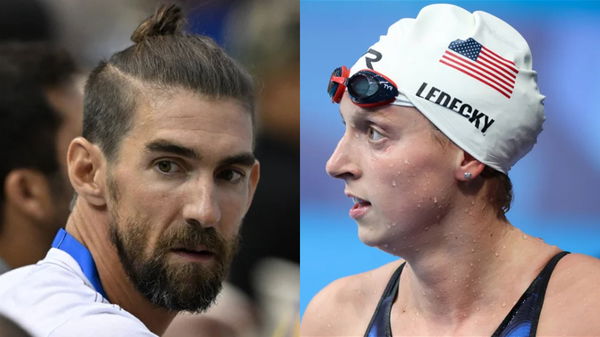
via Imago
Credits – Imago

via Imago
Credits – Imago
Katie Ledecky first met Michael Phelps when she was six. Little did she know, that one day she would surpass the swimming great. But that is exactly what she did in 2023. Now, as she gears up for the 2024 Olympic trials, having won seven gold medals at the previous three editions of the Games, she is eyeing more glory. Not only that, her memoir ‘Just Add Water: My Swimming Life’ hit the shelves on June 11 and she made some interesting revelations about her swimming career, influenced by Phelps.
In an enlightening excerpt from Katie Ledecky’s memoir, the swimming icon drew a comparison between her physique and that of Michael Phelps, sparking the genesis of her renowned “gallop stroke.” Ledecky reflected on a pivotal moment in her swimming career when she underwent a recalibrating session with her coach, Yuri Suguiyama to overcome her shortcomings.
This session led to a modification in her swimming style, inspired by observing Michael Phelps’s technique in a video shared by Yuri. She noted that the Flying Fish exhibited a similar galloping form, which intrigued her.
ADVERTISEMENT
Article continues below this ad
However, a moment stood out in her memoir where Katie Ledecky revealed, “Unlike Michael Phelps’s physique, which is widely considered genetically predisposed for swimming, my body is not tailor-made for the water. As far as physical proportional advantages go, I have zero.” But what does tailor-made mean?

via Getty
INDIANAPOLIS, INDIANA – JULY 01: Katie Ledecky answers questions from journalists on day five of the Phillips 66 National Championships at Indiana University Natatorium on July 01, 2023 in Indianapolis, Indiana. (Photo by Maddie Meyer/Getty Images)
Well, biologically talking, given Phelps’ height is 6’4”, his upper torso is as long as that of a 6’8”; and legs of a 5’10” tall person. This unique physique gives him an advantage of tremendous upper body strength which aids him in pulling through water. Only if that wasn’t enough, his feet size is 14! As quoted by swimming coach and former Olympic medallist Clay Evans, “the ankle flexibility is what pushes water backwards so that you go forward,” and with an ankle flexibility so incredible, and feet so big, ” it’s a big flipper with the capability of moving in the right direction.” And that’s just not all.
In addition to the above physical uniqueness, somehow, Phelps’ body produces less lactic acid than other normal people causing lesser fatigue! These were the advantages Phelps had, whom Ledecky first met outside the Eppley Recreation Center Natatorium at the University of Maryland in 2003. She was able to get a signed swim cap from Phelps, a moment to cherish for the young Ledecky.
But how did she and her coach Yuri Suguiyama ensured that she compensates for the lack of physical attributes that aided Phelps?
Katie Ledecky opened up about how she and her coach worked tirelessly to refine her stroke, aiming to establish a swift connection with the water. She shared, “We wanted to create a quick connection to the water. Using a high elbow catch, we made sure my arms were never up in the air for long.” Ledecky even shared insights into how her infamous technique, the “gallop,” came about. She shared how she glided a little longer on one side before switching.
“With a galloping or loping stroke, there’s a fine line between galloping that moves you forward with increasing speed and galloping that bobbles your body up and down so much you go slower (and look a bit goofy).” This helped her move faster like a sailboat catching the wind. She also had to be careful not to bob up and down too much, or it would slow her down. Her Stanford coach, Greg Meehan, often described her stroke as one where she grabbed and held a significant amount of water throughout her pull.

via Getty
OMAHA, NE – JULY 03: (L-R) Michael Phelps and Katie Ledecky of the United States celebrate during Day Eight of the 2016 U.S. Olympic Team Swimming Trials at CenturyLink Center on July 3, 2016 in Omaha, Nebraska. (Photo by Tom Pennington/Getty Images)
This technique, repeated consistently, allowed Ledecky to navigate the pool with remarkable speed and efficiency, ultimately contributing to her success as an elite swimmer. Last year, she surpassed Phelps for the most career individual world swimming titles, winning her 16th title at the World Aquatic Championships in Fukuoka, Japan, in July. But now she is targeting more history.
ADVERTISEMENT
Article continues below this ad
Katie Ledecky eyes more Olympics glory
Ledecky shot to stardom after she won the 800m freestyle at London Olympics, aged just 15. She followed it up by adding three individual titles (200m, 400m, 800m freestyle) at Rio 2016 and added two more gold medals in Tokyo (800m and 1500m freestyle), to become the most decorated Olympic swimmer in her gender.
ADVERTISEMENT
Article continues below this ad
Now, with Paris in sight, her ambition and hunger hasn’t wavered. Starting her Olympic journey at the age of 15, she is now seen as a veteran and will be eager to lead her nation at the upcoming Games. In an interview with the PEOPLE, she said, “I wouldn’t have been able to see into the future that I would be competing in 2024. So yeah, I don’t take it for granted. I don’t take these opportunities for granted, and I just try to enjoy each day of the training and the process.”
With the trials looming, fans eagerly await to see how she has honed these techniques and how they will serve as her catalyst toward the Paris Olympics. What are your thoughts on this glimpse into her swimming journey? Comment below!
ADVERTISEMENT
ADVERTISEMENT
ADVERTISEMENT
ADVERTISEMENT

